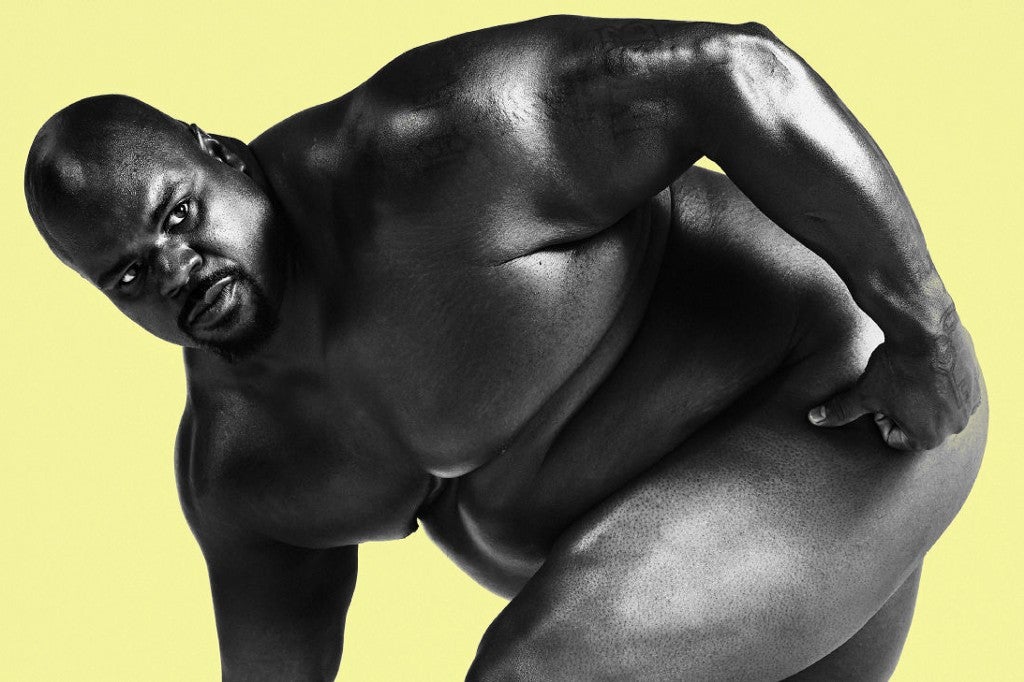Last year, ESPN: The Magazine dedicated several pages of its annual Body issue to the 6-foot-2, 325-pound frame of Vince Wilfork.
Vince Wilfork is the best. pic.twitter.com/KMI11J9huz
— Rachel Marcus (@rachelnmarcus) June 30, 2016
The issue is famous for celebrating the kinds of bodies you’d typically never see in a magazine, but Wilfork’s inclusion was considered particularly notable given his exceptional girth. Wilfork himself heralded the photo shoot as a milestone for body positivity:
Outside of his pads, you’d never assume Wilfork is a professional athlete. In fact, you might simply assume he was obese. But within the realm of football, Wilfork was not only accepted for his size; he was one of the best players in the league because of it. (He retired from the NFL last week — with a sponcon announcement that involved his smoking ribs on behalf of Kingford Charcoal, his size dominating the conversation one last time.)
For a sport quickly losing its escapist quality — thanks to concussions and CTE; billionaire owners who rob city coffers to fund their new stadiums; and an equally corrupt college game that makes hundreds of millions of dollars from the unpaid labor of “student” athletes — the fact remains that football is one of the few cultural institutions that actively embraces fat boys.
We typically don’t recognize body issues in men, but we’re learning that growing up fat can often be just as damaging for boys. “We don’t really think about fat-shaming men, but the pain is real,” according to Purdue business professor Richard Feinberg. Boys grow up worshipping comic book superheroes with impossible musculatures, and Hollywood action stars who starve themselves for roles. No wonder, then, steroid use and body dysmorphia are on the rise among men in the U.S.
But football is the exception to this rule; it’s the rare haven where fatness is not only normalized but celebrated. The nature of the sport dictates a need for the kinds of stocky boys who tend not to excel at other major sports, but make for hard-to-move interior lineman. Or the kind of lumbering, overgrown Goliaths who might not have the foot dexterity for basketball, but are essential for holding down the edge on defense. Or pear-shaped young men who, with a little training, can become terrific linebackers.
This wide array of body types is on full display in this year’s edition of Hard Knocks, the HBO docuseries about the Tampa Bay Buccaneers training camp. The show puts a special focus on several star players, including wide receiver DeSean Jackson (a 5-foot-10, 175-pound speedster), wide receiver Mike Evans (who at 6-foot-5 and 225 pounds has one of the most impressive physiques in the game), monstrous defensive tackle Gerald McCoy (6-foot-4, 300 pounds) and quarterback Jameis Winston, who’s known to suffer from a rare condition known as Uncle Bod.
Each is a superstar in his own right, and each has a body type that speaks to the unique demands of their respective positions. Collectively, they span the entire range of the male form. There’s a position for every body in football, and a body for every position.
Not that fat kids are precluded from playing other sports. It’s just that their presence is rarer, and met with a kind of gawking that verges on fat-shaming. Take, for instance, Jeffrey “Boog” Powell, the 5-foot-2, 220-pound 12-year-old Little League player who became something of a viral sensation last week when people shared images of him waddling around the basepaths.
JP Boog with a POWERFUL RBI single #electricfactory pic.twitter.com/vh09tz9f7I
— Barstool Sports (@barstoolsports) August 8, 2017
Put Powell on a football roster, however, and he’s no longer a sideshow. If anything, he becomes an absolute force as an interior lineman. And there’s no overstating what that can do for the self-confidence of a young boy who might feel strange about being so much larger than all the boys his age. I was an overweight, introverted oaf until I find football, where having an enormous ass suddenly worked to my advantage.
Indeed, a Texas A&M study of Division I male baseball, basketball and football players published earlier this year found that football players were actually more satisfied with their bodies than baseball players, despite being the by far the heaviest players, on average.
“I’ve known this weight since I was a sophomore in high school,” Wilfork once said in an interview about his ESPN photo shoot. “I know there’ll be people talking, ‘He’s obese’ and ‘He’s this.’ Oh, well. I’m proud of who I am. I’m proud of my body.”
It’s hard to believe Wilfork would be so proud of his size had it not been a primary contributor to his professional success—and that’s something few things outside of football can provide.
